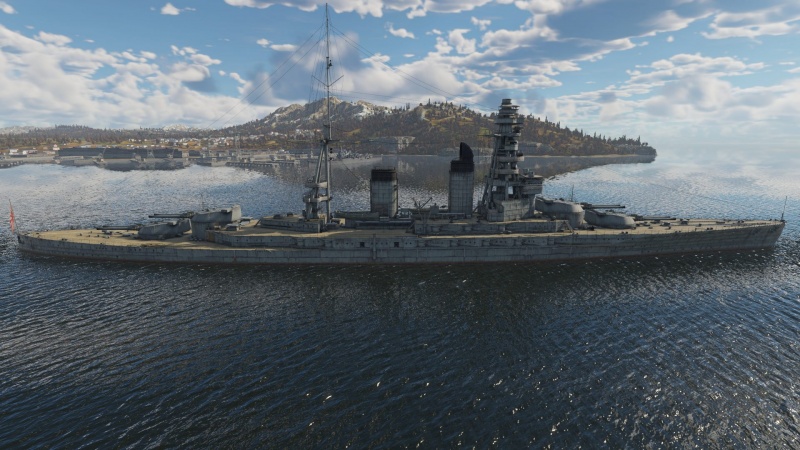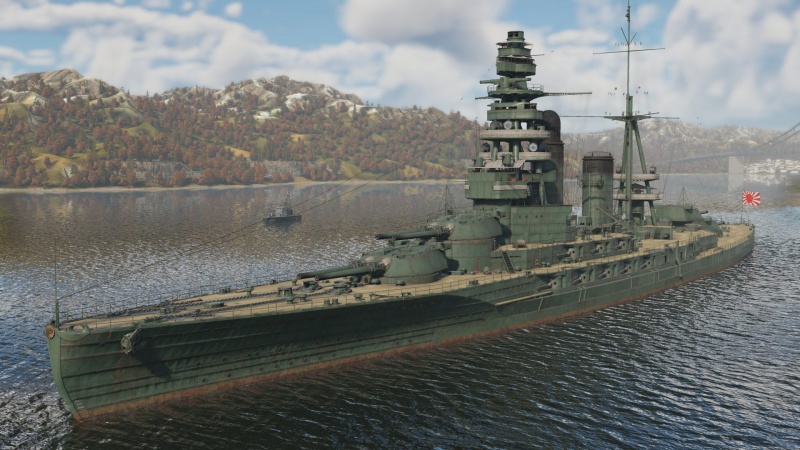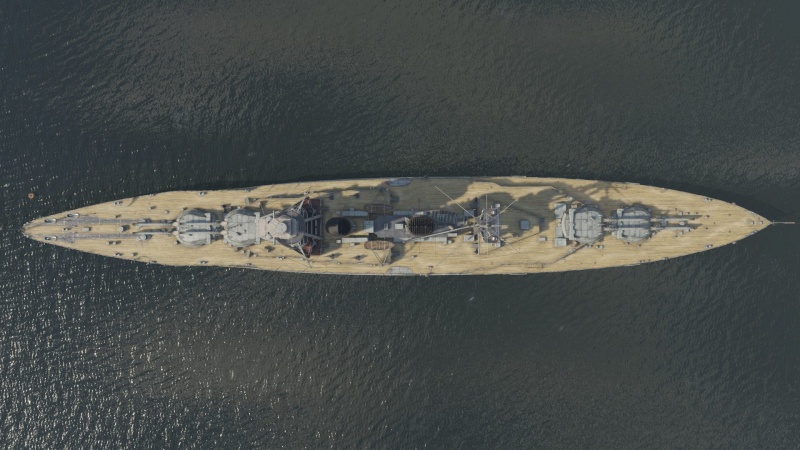IJN Mutsu
Contents
Description
The Nagato-class battleship Mutsu of the Imperial Japanese Navy was laid down in 1918, launched in 1920, and commissioned in 1921. She was one of the "Big 7" battleships allowed to retain 16-inch guns under the Washington Naval Treaty. She played a significant role in Japan's interwar policy. During the Second World War, Mutsu participated in several operations, including the Battle of Midway and the Guadalcanal campaign, though she never engaged in direct combat. Her career came to an end on 8 June 1943 when a magazine explosion at Hashirajima anchorage split the ship in two, resulting in the loss of 1,121 crew members.
The Nagato-class, IJN Mutsu, 1922 was introduced in Update "Alpha Strike". She was the first 16-inch vessel in the game, trading excellent damage output for lower survivability, particularly due to her aft magazines being exposed above the waterline. She is also a very easy target for enemy bombers, being defended solely by four 76 mm guns. Overall, though, she is an excellent surface combatant and one of the most dangerous enemies in the top tier.
General info
Survivability and armour
Talk about the vehicle's armour. Note the most well-defended and most vulnerable zones, e.g. the ammo magazine. Evaluate the composition of components and assemblies responsible for movement and manoeuvrability. Evaluate the survivability of the primary and secondary armaments separately. Don't forget to mention the size of the crew, which plays an important role in fleet mechanics. Save tips on preserving survivability for the "Usage in battles" section. If necessary, use a graphical template to show the most well-protected or most vulnerable points in the armour.
Mobility
Write about the ship's mobility. Evaluate its power and manoeuvrability, rudder rerouting speed, stopping speed at full tilt, with its maximum forward and reverse speed.
| Mobility Characteristics | |||
|---|---|---|---|
| Game Mode | Upgrade Status | Maximum Speed (km/h) | |
| Forward | Reverse | ||
| AB | |||
| Upgraded | |||
| RB/SB | |||
| Upgraded | |||
Modifications and economy
Armament
Primary armament
Provide information about the characteristics of the primary armament. Evaluate their efficacy in battle based on their reload speed, ballistics and the capacity of their shells. Add a link to the main article about the weapon: {{main|Weapon name (calibre)}}. Broadly describe the ammunition available for the primary armament, and provide recommendations on how to use it and which ammunition to choose.
| Penetration statistics | |||||||
|---|---|---|---|---|---|---|---|
| Ammunition | Type of warhead |
Penetration @ 0° Angle of Attack (mm) | |||||
| 1,000 m | 2,500 m | 5,000 m | 7,500 m | 10,000 m | 15,000 m | ||
| Common Type 0 | HE | 71 | 71 | 71 | 71 | 71 | 71 |
| No3 APC | APCBC | 728 | 665 | 574 | 499 | 439 | 361 |
| No5 APC | APCBC | 775 | 715 | 626 | 553 | 492 | 406 |
| Shell details | ||||||||||||
|---|---|---|---|---|---|---|---|---|---|---|---|---|
| Ammunition | Type of warhead |
Velocity (m/s) |
Projectile mass (kg) |
Fuse delay (s) |
Fuse sensitivity (mm) |
Explosive mass (TNT equivalent) (kg) |
Ricochet | |||||
| 0% | 50% | 100% | ||||||||||
| Common Type 0 | HE | 805 | 936 | 0 | 0.1 | 46.52 | 79° | 80° | 81° | |||
| No3 APC | APCBC | 760 | 1,000 | 0.05 | 26 | 12.66 | 48° | 63° | 71° | |||
| No5 APC | APCBC | 790 | 1,000 | 0.05 | 26 | 12.66 | 48° | 63° | 71° | |||
Secondary armament
Some ships are fitted with weapons of various calibres. Secondary armaments are defined as weapons chosen with the control Select secondary weapon. Evaluate the secondary armaments and give advice on how to use them. Describe the ammunition available for the secondary armament. Provide recommendations on how to use them and which ammunition to choose. Remember that any anti-air armament, even heavy calibre weapons, belong in the next section. If there is no secondary armament, remove this section.
| Penetration statistics | |||||||
|---|---|---|---|---|---|---|---|
| Ammunition | Type of warhead |
Penetration @ 0° Angle of Attack (mm) | |||||
| 1,000 m | 2,500 m | 5,000 m | 7,500 m | 10,000 m | 15,000 m | ||
| Mod 1 SAP | SAPBC | 115 | 100 | 81 | 65 | 54 | 40 |
| Shell details | ||||||||||||
|---|---|---|---|---|---|---|---|---|---|---|---|---|
| Ammunition | Type of warhead |
Velocity (m/s) |
Projectile mass (kg) |
Fuse delay (s) |
Fuse sensitivity (mm) |
Explosive mass (TNT equivalent) (kg) |
Ricochet | |||||
| 0% | 50% | 100% | ||||||||||
| Mod 1 SAP | SAPBC | 855 | 37.87 | 0.05 | 6 | 2.21 | 48° | 63° | 71° | |||
Anti-aircraft armament
An important part of the ship's armament responsible for air defence. Anti-aircraft armament is defined by the weapon chosen with the control Select anti-aircraft weapons. Talk about the ship's anti-air cannons and machine guns, the number of guns and their positions, their effective range, and about their overall effectiveness – including against surface targets. If there are no anti-aircraft armaments, remove this section.
Additional armament
Describe the available additional armaments of the ship: depth charges, mines, torpedoes. Talk about their positions, available ammunition and launch features such as dead zones of torpedoes. If there is no additional armament, remove this section.
Usage in battles
Describe the technique of using this ship, the characteristics of her use in a team and tips on strategy. Abstain from writing an entire guide – don't try to provide a single point of view, but give the reader food for thought. Talk about the most dangerous opponents for this vehicle and provide recommendations on fighting them. If necessary, note the specifics of playing with this vehicle in various modes (AB, RB, SB).
Pros and cons
Summarise and briefly evaluate the vehicle in terms of its characteristics and combat effectiveness. Mark its pros and cons in the bulleted list. Try not to use more than 6 points for each of the characteristics. Avoid using categorical definitions such as "bad", "good" and the like - use substitutions with softer forms such as "inadequate" and "effective".
Pros:
Cons:
History
The battleship Mutsu was laid down at Yokosuka Navy Yard on 1 June 1918 and launched on 31 May 1920. Along with Nagato, she was one of Japan's most capable warships at the time of commissioning in October 1921, quickly becoming a symbol of national pride and a central element of the First Fleet. During her early years, Mutsu took part in various naval manoeuvres, including a high-profile visit from the Prince of Wales in 1922. The battleship also played a significant role during Japan's withdrawal from Siberia and participated in relief efforts following the Great Kanto Earthquake in September 1923. In the 1930s, she underwent multiple refits to modernise her armament, propulsion, and defences.
Mutsu played a significant role in the Washington Naval Treaty negotiations of 1922. Initially slated for scrapping, Japanese delegates successfully argued for her retention, citing her recent commissioning and operational status. This decision made Mutsu one of the "Big 7" battleships, vessels allowed to retain their 16-inch (406 mm) main guns under the treaty. The "Big 7" also included her sister ship Nagato, three American Colorado-class, and two British Nelson-class battleships. Her preservation under the treaty ensured Japan maintained a strong naval presence in the interwar period, though it came at the cost of allowing other nations to build additional capital ships to maintain the agreed-upon ratios.
During World War II, Mutsu was part of the Combined Fleet's 1st Battleship Division, primarily operating in Japanese home waters. She participated in Operation Z, the attack on Pearl Harbor, by patrolling the Ogasawara Islands. Later, she participated in the Battle of Midway as part of the Main Body from 4-5 June 1942. In the latter half of 1942, she supported operations in the Guadalcanal campaign. July 1942 saw her transfer to the 2nd Battleship Division, where she continued to serve, avoiding direct engagement in significant naval battles. Her limited operational use reflected Japan's strategic priority on conserving capital ships as the war situation became increasingly dire.
On 8 June 1943, while anchored at Hashirajima, Mutsu suffered a catastrophic internal explosion in her No. 3 magazine, splitting the ship in two. The cause of the explosion remains debated, with theories ranging from accidental detonation to sabotage. The sinking resulted in the loss of over 1,121 officers and crew, marking a tragic end for one of Japan's greatest battleships.
Devblog
As part of the naval rearmament program leading up to and during WWI, the Japanese navy was constructing a number of new battleships and battlecruisers, incorporating the latest technologies. IJN Mutsu was one of these ships, being ordered into construction in June 1918 and seeing completion in 1921. Along with her sistership, IJN Nagato, they were the first warships in the world to be fitted with 16" cannons, which greatly increased their firepower and range. Being subject to several upgrades and modernizations in the interwar period, Mutsu entered WWII as one of the most powerful battleships in the world. However, this warship only saw limited combat action and was tragically lost in 1943 while at port due to a catastrophic magazine detonation which destroyed the ship and caused many losses.
Media
Excellent additions to the article would be video guides, screenshots from the game, and photos.
See also
Links to articles on the War Thunder Wiki that you think will be useful for the reader, for example:
- reference to the series of the ship;
- links to approximate analogues of other nations and research trees.
External links
- [Devblog] IJN Mutsu: Setting New Standards!
- [Wikipedia] Japanese battleship Mutsu
- [大日本帝国軍 主要兵器] 陸奥【長門型戦艦 二番艦】Mutsu【Nagato-class battleship Second】
- [Combined Fleet] IJN MUTSU: Tabular Record of Movement
- [World War II Database] Battleship Mutsu
| Yokosuka Naval Arsenal (横須賀海軍工廠) | |
|---|---|
| Destroyers (DD) | |
| Momi-class | IJN Momi |
| Light Cruisers (CL) | |
| Mogami-class | IJN Suzuya |
| Heavy Cruisers (CA) | |
| Myōkō-class | IJN Myoko |
| Battlecruisers (BC) | |
| Kurama-class | IJN Kurama |
| Amagi-class | IJN Amagi |
| Battleships (BB) | |
| Fusō-class | IJN Yamashiro |
| Nagato-class | IJN Mutsu |
| Tanks | Ka-Mi · Ka-Chi · Chi-Ha LG |
| See also | Yokosuka Naval Air Technical Arsenal |
| Japan battleships | |
|---|---|
| Kawachi-class | IJN Settsu |
| Fusō-class | IJN Fuso · IJN Yamashiro |
| Ise-class | IJN Ise · IJN Hyuga |
| Kongō-class | IJN Kongo · IJN Haruna |
| Nagato-class | IJN Mutsu |







